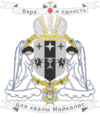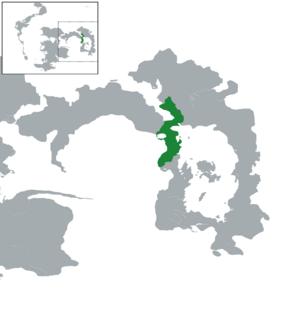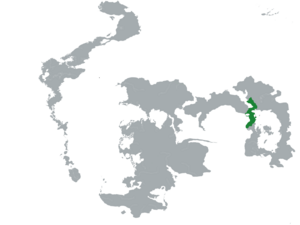Mychenar: Difference between revisions
(Filled in infobox; wrote overview paragraphs.) |
(Added parts of history) |
||
| Line 103: | Line 103: | ||
The name of Mykalimonia is primarily derived from Mykalis Althaea, who was a divine prophet and the main figure in Mykalimonian religion. The name was adopted as a demonym for followers of Mykalis, and the Bassiliyan exiles were had agreed on naming their country and themselves after their late-prophet. | The name of Mykalimonia is primarily derived from Mykalis Althaea, who was a divine prophet and the main figure in Mykalimonian religion. The name was adopted as a demonym for followers of Mykalis, and the Bassiliyan exiles were had agreed on naming their country and themselves after their late-prophet. | ||
==History== | ==History== | ||
Evidence of historical documents support Mykalimonians being descendants from what is today the Holy Empire of Bassiliya. Mykalimonians were forced out of Juliae by Krotoi-occupied Juliae in the early-500s, but documents of history before the Mykalimonian exodus exists in the nation. | |||
===Juliaen Period=== | |||
Many historical scribes claim that the early Mykalimonians descend from present-day Bassiliya. The earlies times that most scribes are confident about trace back to the Ancient Tribal Era. In this era, it is noted that four tribes existed: the Juliae, Heptameri, Melatos, and the Zervatos. These four tribes all worshiped a common religion named Skajizam. Skajizam revolved around the existence of spirits and deities in the sky. At one point in the history of the tribes, they entered a period of conflict, coloquially known as the [[Ancient Conflicts]]. These conflicts, which lasted for approximately four centuries came to and end as a stalemate. This was primarily caused by diminishing populations on the border as large battles ensued between the Juliae and Zervatos tribes. Peace would reign over these tribes until a century later, in which they would become enemies once again in the [[Juli-Zervatos War]] as they fought over the western regions. Two decades afterwars would see the second declaration of peace between the tribes which would end hostilities for the foreseeable future. | |||
During this period of peace, the Juliae and Zervatos grew both in wealth and influence, primarily through trade and commerce. The discovery of metals such as gold and silver led to a economic boom in the Zervatos' mining industries. The Juliae themselves benefitted from this industrial and economic boom by supplying the necessary resources involved in mining. 244 IE saw the beginning of the [[Second Juli-Zervatos War]]. This conflict saw the subjugation of the Zervatos under Juliaen rule. After the conflict ended, the next two centuries would see the complete yet peaceful integration of Zervatos culture into Juliaen society. | |||
Circa 460 IE saw the ancient and powerful Empire of Peraro Krotoik looking to expand east while swallowing neighboring tribes to the west of Juliae. Fearing for their destruction by the Krotoi, the Juliae begin a military buildup. Soon afterwards, the Juliae would see themselves trying to manage small border conflicts all along the western borders of the Juliae and Krotoik. To the Juliaen's misfortune, a group of ethnics from the tribe of Zervatos incited a rebellion due to cultural grievances, causing the ''glaven'' Lazo Panamito to attempt to put down the rebellion. This attempt to contain the rebellion utterly failed, in-turn allowing the Zervatos to flee west into Krotoik lands. Noticing this, the Krotoika invaded the Juliae in mid-480 IE, beginning what would be called the [[Krotoik Invasion of Juliae]]. This invasion saw much of the western regions of the Juliae lost to the Krotoi. Consecutive costly defensive losses for the next year would see the Juliae surrender after the [[Battle of Predavnik]], citing the end of Juliaen hegemony and the beginning of Krotoik occupation. | |||
===Krotoik occupation and Mykalimonian expulsion=== | |||
The surrender of the Juliae marked a pivotal change for Juliaen culture. The appointment of the first governor per the generous treaty by the Peraro Krotoik saw Mirko Vasiliadis appointed. Vasiliadis soon referred to himself as Mirko Juliae. Mirko oversaw the absorption of many cultural customs and traditions of the Krotoika as well as ethnicities onto the former Juliaen culture. During this period, an important figure in present-day Mykalimonian society, [[Mykalis Althaea]], was born. Mykalis would form the foundation of the religion that is called Mykalism. Her parents through Mykalist manuscripts, described that they felt Mykalis was no ordinary human, but something higher than that. They then began to explain their feelings to their close neighbors about Mykalis. As Mykalis reached her late 20s, manuscripts describe Mykalis traveling from city to city in Krotoik-occupied Juliae proclaiming her divinity and connections to the cosmos. Many manuscripts also described Mykalis performing miracles and bestowing blessings upon those who had fallen ill or had become disabled; something one could not normally do in the flesh. She also taught many people of the rules that they must follow in order to be a true adherent towards her. This prompted a huge following of people who began to praise and worship her for her deeds. However, these acts did not go unnoticed by the Krotoika. Krotoik authorities began to silence worshippers of Mykalis almost immediately with arrests and floggings, as it was against Otoism to worship a deity supreme to Oto. It rapidly escalated to torture and executions as it was becoming more widely known. In 531 IE, a warrant for Mykalis' arrest would be issued as she began to speak about a desire for a Juliaen rebirth and proceeded to produce a highly-inflammatory sermon. She would be found relatively quickly, arrested and tried quickly for her crimes. It was decided quickly that she would be condemned and put to death via stoning. While imprisoned in Soncetopilay, Mykalis was said to have been beaten consistently each day until her death. | |||
Early scholars of Mykalimonia have few but accurate recordings on Mykalis' imprisonment. During her imprisonment, a large group of followers incited a rebellion against the Krotoika citing discriminatory treatment of Mykalis and the overwhelming desire for a Juliaen rebirth. This rebellion would kick off the [[Mykalimonian Schism]]. The rebellion consisted of several thousand Juliaens who ravaged through homes belonging to Krotoik citizens. Violent clashes against the Krotoik authorities also occurred. The rebellion would see its end after a week as Krotok authorities gathered who contributed to the rebellion to watch Mykalis' death by the Krotoi. It is recorded that Mykalis condemned the Empire of Peraro Krotoik and supposedly laid out a curse that the Empire would one day fall. She also proclaimed her divinity and association to the cosmos for the last time before she died. | |||
Following her death, a short and violent uprising began again leading to many deaths for both parties. The remaining population of followers would either be forced into hiding or be rounded up and exiled from the Peraro Krotoik. Grieving their divine deity, they coined themselves in her honor as Mykalimonians, and set off to the outskirts of the Peraro Krotoik. | |||
===Mykalimonian Exodus=== | |||
Mykalis left three offspring to inherit her legacy with the exiled Mykalimonians. Shortly after their expulsion, Mykalism was born as a new religion that worshipped the late Mykalis, who was now in her completed form in the cosmos. Coming to terms with what had occurred, they had to start from square one, but they were afraid of settling too close to the Empire of Peraro Krotoik as they would likely be killed and pillaged. They began to travel east. They would soon encounter and cross the strait that separated the continents of Oskiya and Kalavik. | |||
Taking into account if they were fortunate enough to expand past the strait, the Mykalimonians thought that it was not enough space between themselves and the Peraro Krotoik to settle. They slowly continued east during their journey. As the journey progressed slowly, Mykalis' offspring and eventually descendants who led the large population gave the exodus reassurance that their ancestor is leading them in the right direction and would let them know when to settle down peacefully. Eventually they would march into a nation named Auraxia who greeted them warmly and gave them as much time as they needed until they needed to continue their journeys, which would be what the Mykalimonians would do after taking a considerable break from the journey. Mykalis' descendants had an instinct that the desired spot was getting closer. After departing from Auraxia, they continued east until they hit the coast of the Lake of Kalavik, where they would settle down and establish a village. Named after the first daughter and leader of the exodus, Alysthenes would be established in 614 IE. The first chief of the town, Jaxon Althaeon and descendant of Mykalis would take charge and oversee the growth of Alysthenes that would be under the blessing of Mykalis for generations to come. | |||
==Geography== | ==Geography== | ||
Revision as of 15:38, 10 February 2023
This article is incomplete because it is pending further input from participants, or it is a work-in-progress by one author. Please comment on this article's talk page to share your input, comments and questions. Note: To contribute to this article, you may need to seek help from the author(s) of this page. |
Empire of Mykalimonia Αυτοκρατορία της Μυκαλιμονίας | |
|---|---|
| Motto: Ομορφιά, Κομψότητα, Αιωνιότητα Beauty, Elegance, Eternity | |
| Capital |
|
| Largest | Alysthenes |
| Official languages | Althaeic Bassiliyan |
| Recognised national languages | Middle Juliaen |
| Recognised regional languages | Old Juliaen |
| Ethnic groups |
|
| Religion | Mykalism |
| Demonym(s) | Mykalimonian |
| Government | Imperial Diarchy |
• Empress | Maia Althaea |
• Shadow Emperor | Norau Althaeon |
| Establishment | |
• Mykalimonian Schism | 531 IE |
• Alysthenes founded | 614 IE |
• House of Althaea established | 616 IE |
• Ok'lizuzati-Mykalimonian War | 916-931 IE |
• Second Cycle of Mykalimonia | 1386 IE |
| Area | |
• Total | 775,280 km2 (299,340 sq mi) (9th) |
| Population | |
• 1385 estimate | ~12.5 million (5th) |
• 1380 census | 12,471,690 |
• Density | 15.99/km2 (41.4/sq mi) (23rd) |
| Currency | Astro (✧) |
The Empire of Mykalimonia (Althaeic Bassiliyan: Mykalimonías; Middle/Old Juliaen: Imperija na Mikalimonija), also known as Mykalimonia or Mychenar, is a large Empire located in west-central Kalavik. It is the most populous country in Kalavik, with the Ok'lizuza Empire following. Mykalimonia directly borders the Ok'lizuza Empire to the north and indirectly borders Eldiastan to the south. Originally banished from the ancient lands of Krotoi-occupied Juliae, Mykalimonia has since established itself as a sovereign Empire. Mykalimonia covers approximately 775,280 square kilometers (299,337.281 square miles), and is the ninth largest nation in regards to known lands claimed. The Empire of Mychenar has recently begun the transition towards an Empire with matriarchal primogeniture with the recent Statute of Succession written and placed into effect in early-1386. Alioth is the royal and executive capital of Mykalimonia, with Alythenes as the economic capital and Hyelaistos as the cultural capital, respectively.
Following the exile of Mykalimonians from Krotoi-occupied Juliae, the people were led by the divine prophet Mykalis Althaea's descendants across and into what is known today as the continent of Kalavik. The large group of exiles would then travel for around three-quarters of a century until establishing Alysthenes. Since establishing Alysthenes, the small nation grew very rapidly, growing to approximately three-quarters of its current size in 730 IE. An royalty was also established shortly after Alystenes was founded. Royalty would be commonplace, as the nation transitioned from a Principality to an Empire throughout its history.
Mykalimonia stands as a highly-developed nation, and as the fifth most-populous nation in the known world with a population of approximately 12.5 million Mykalimonians. Highly pacifistic and focused on its culture, Mykalimonia claims to be the nation of the highest-class in Kalavik. With its population and economic status, the Empire of Mykalimonia is an influential economic and cultural power on Kalavik.
Name
The name of Mykalimonia is primarily derived from Mykalis Althaea, who was a divine prophet and the main figure in Mykalimonian religion. The name was adopted as a demonym for followers of Mykalis, and the Bassiliyan exiles were had agreed on naming their country and themselves after their late-prophet.
History
Evidence of historical documents support Mykalimonians being descendants from what is today the Holy Empire of Bassiliya. Mykalimonians were forced out of Juliae by Krotoi-occupied Juliae in the early-500s, but documents of history before the Mykalimonian exodus exists in the nation.
Juliaen Period
Many historical scribes claim that the early Mykalimonians descend from present-day Bassiliya. The earlies times that most scribes are confident about trace back to the Ancient Tribal Era. In this era, it is noted that four tribes existed: the Juliae, Heptameri, Melatos, and the Zervatos. These four tribes all worshiped a common religion named Skajizam. Skajizam revolved around the existence of spirits and deities in the sky. At one point in the history of the tribes, they entered a period of conflict, coloquially known as the Ancient Conflicts. These conflicts, which lasted for approximately four centuries came to and end as a stalemate. This was primarily caused by diminishing populations on the border as large battles ensued between the Juliae and Zervatos tribes. Peace would reign over these tribes until a century later, in which they would become enemies once again in the Juli-Zervatos War as they fought over the western regions. Two decades afterwars would see the second declaration of peace between the tribes which would end hostilities for the foreseeable future.
During this period of peace, the Juliae and Zervatos grew both in wealth and influence, primarily through trade and commerce. The discovery of metals such as gold and silver led to a economic boom in the Zervatos' mining industries. The Juliae themselves benefitted from this industrial and economic boom by supplying the necessary resources involved in mining. 244 IE saw the beginning of the Second Juli-Zervatos War. This conflict saw the subjugation of the Zervatos under Juliaen rule. After the conflict ended, the next two centuries would see the complete yet peaceful integration of Zervatos culture into Juliaen society.
Circa 460 IE saw the ancient and powerful Empire of Peraro Krotoik looking to expand east while swallowing neighboring tribes to the west of Juliae. Fearing for their destruction by the Krotoi, the Juliae begin a military buildup. Soon afterwards, the Juliae would see themselves trying to manage small border conflicts all along the western borders of the Juliae and Krotoik. To the Juliaen's misfortune, a group of ethnics from the tribe of Zervatos incited a rebellion due to cultural grievances, causing the glaven Lazo Panamito to attempt to put down the rebellion. This attempt to contain the rebellion utterly failed, in-turn allowing the Zervatos to flee west into Krotoik lands. Noticing this, the Krotoika invaded the Juliae in mid-480 IE, beginning what would be called the Krotoik Invasion of Juliae. This invasion saw much of the western regions of the Juliae lost to the Krotoi. Consecutive costly defensive losses for the next year would see the Juliae surrender after the Battle of Predavnik, citing the end of Juliaen hegemony and the beginning of Krotoik occupation.
Krotoik occupation and Mykalimonian expulsion
The surrender of the Juliae marked a pivotal change for Juliaen culture. The appointment of the first governor per the generous treaty by the Peraro Krotoik saw Mirko Vasiliadis appointed. Vasiliadis soon referred to himself as Mirko Juliae. Mirko oversaw the absorption of many cultural customs and traditions of the Krotoika as well as ethnicities onto the former Juliaen culture. During this period, an important figure in present-day Mykalimonian society, Mykalis Althaea, was born. Mykalis would form the foundation of the religion that is called Mykalism. Her parents through Mykalist manuscripts, described that they felt Mykalis was no ordinary human, but something higher than that. They then began to explain their feelings to their close neighbors about Mykalis. As Mykalis reached her late 20s, manuscripts describe Mykalis traveling from city to city in Krotoik-occupied Juliae proclaiming her divinity and connections to the cosmos. Many manuscripts also described Mykalis performing miracles and bestowing blessings upon those who had fallen ill or had become disabled; something one could not normally do in the flesh. She also taught many people of the rules that they must follow in order to be a true adherent towards her. This prompted a huge following of people who began to praise and worship her for her deeds. However, these acts did not go unnoticed by the Krotoika. Krotoik authorities began to silence worshippers of Mykalis almost immediately with arrests and floggings, as it was against Otoism to worship a deity supreme to Oto. It rapidly escalated to torture and executions as it was becoming more widely known. In 531 IE, a warrant for Mykalis' arrest would be issued as she began to speak about a desire for a Juliaen rebirth and proceeded to produce a highly-inflammatory sermon. She would be found relatively quickly, arrested and tried quickly for her crimes. It was decided quickly that she would be condemned and put to death via stoning. While imprisoned in Soncetopilay, Mykalis was said to have been beaten consistently each day until her death.
Early scholars of Mykalimonia have few but accurate recordings on Mykalis' imprisonment. During her imprisonment, a large group of followers incited a rebellion against the Krotoika citing discriminatory treatment of Mykalis and the overwhelming desire for a Juliaen rebirth. This rebellion would kick off the Mykalimonian Schism. The rebellion consisted of several thousand Juliaens who ravaged through homes belonging to Krotoik citizens. Violent clashes against the Krotoik authorities also occurred. The rebellion would see its end after a week as Krotok authorities gathered who contributed to the rebellion to watch Mykalis' death by the Krotoi. It is recorded that Mykalis condemned the Empire of Peraro Krotoik and supposedly laid out a curse that the Empire would one day fall. She also proclaimed her divinity and association to the cosmos for the last time before she died.
Following her death, a short and violent uprising began again leading to many deaths for both parties. The remaining population of followers would either be forced into hiding or be rounded up and exiled from the Peraro Krotoik. Grieving their divine deity, they coined themselves in her honor as Mykalimonians, and set off to the outskirts of the Peraro Krotoik.
Mykalimonian Exodus
Mykalis left three offspring to inherit her legacy with the exiled Mykalimonians. Shortly after their expulsion, Mykalism was born as a new religion that worshipped the late Mykalis, who was now in her completed form in the cosmos. Coming to terms with what had occurred, they had to start from square one, but they were afraid of settling too close to the Empire of Peraro Krotoik as they would likely be killed and pillaged. They began to travel east. They would soon encounter and cross the strait that separated the continents of Oskiya and Kalavik.
Taking into account if they were fortunate enough to expand past the strait, the Mykalimonians thought that it was not enough space between themselves and the Peraro Krotoik to settle. They slowly continued east during their journey. As the journey progressed slowly, Mykalis' offspring and eventually descendants who led the large population gave the exodus reassurance that their ancestor is leading them in the right direction and would let them know when to settle down peacefully. Eventually they would march into a nation named Auraxia who greeted them warmly and gave them as much time as they needed until they needed to continue their journeys, which would be what the Mykalimonians would do after taking a considerable break from the journey. Mykalis' descendants had an instinct that the desired spot was getting closer. After departing from Auraxia, they continued east until they hit the coast of the Lake of Kalavik, where they would settle down and establish a village. Named after the first daughter and leader of the exodus, Alysthenes would be established in 614 IE. The first chief of the town, Jaxon Althaeon and descendant of Mykalis would take charge and oversee the growth of Alysthenes that would be under the blessing of Mykalis for generations to come.
Geography
Demographics
Government
Economy
Culture
Military
See also
Notes



